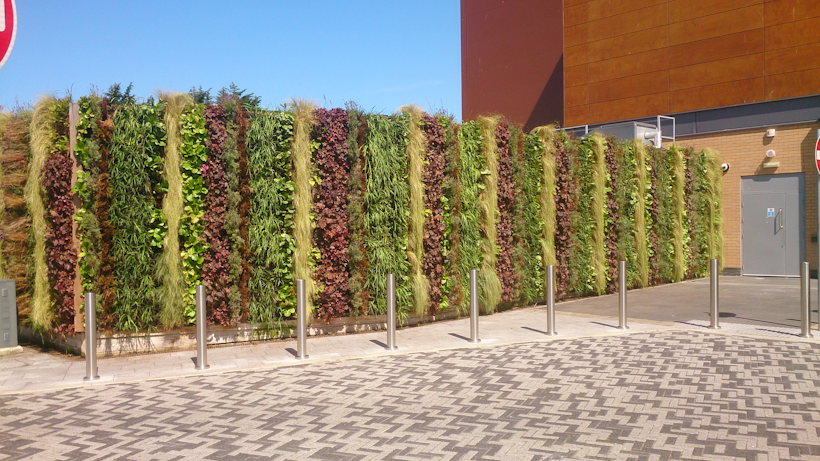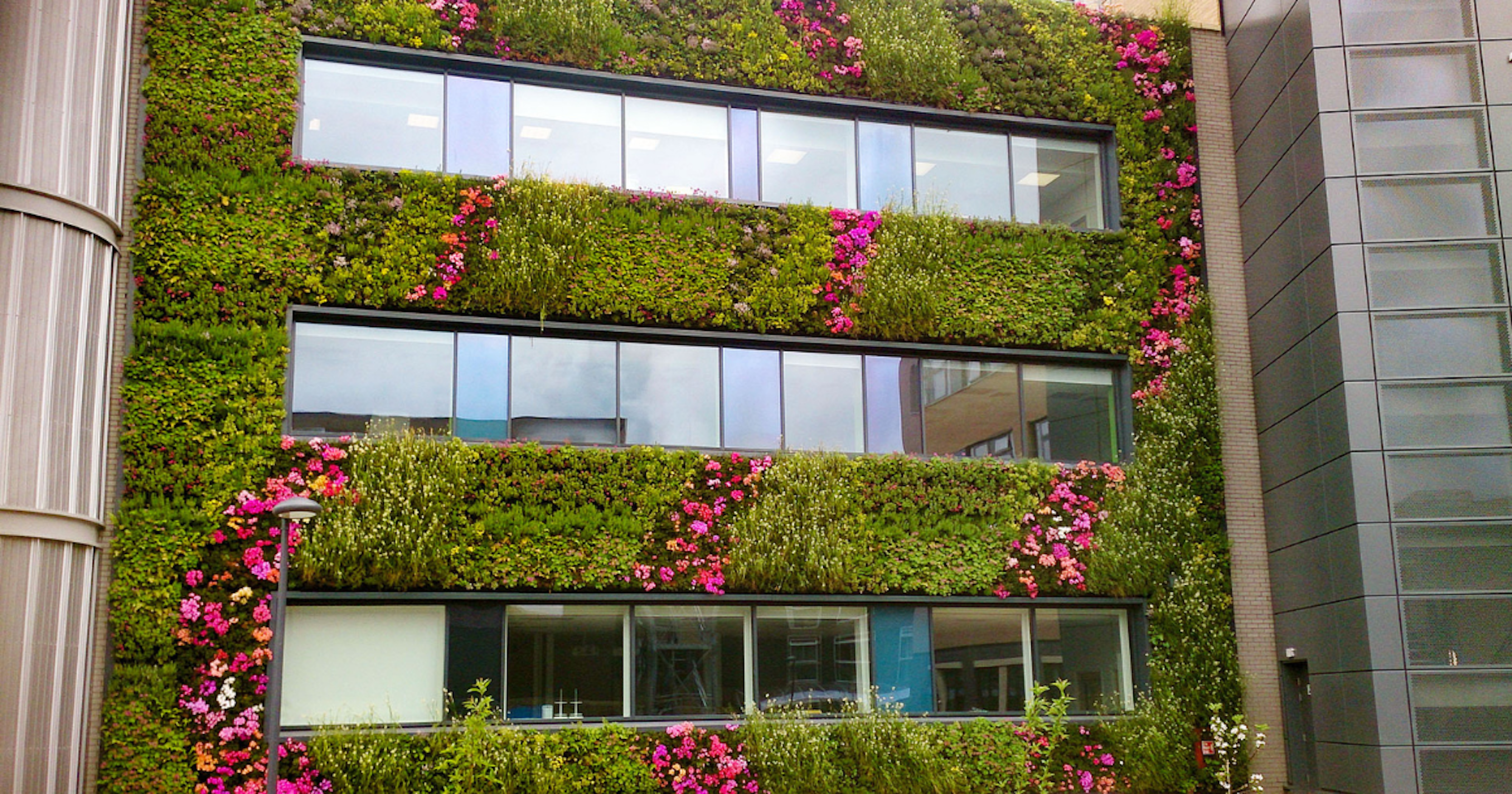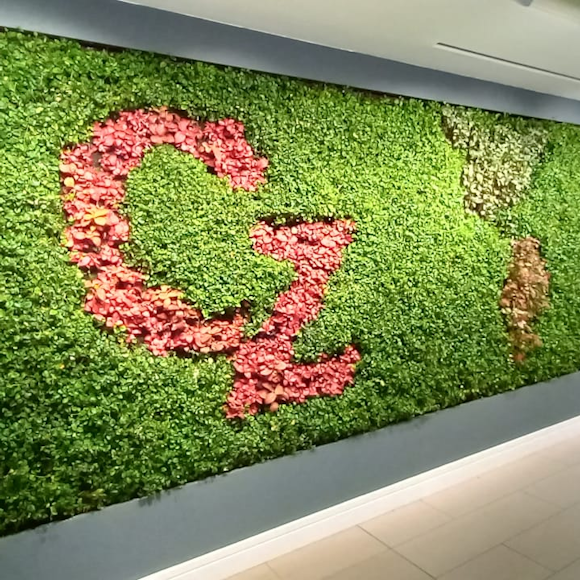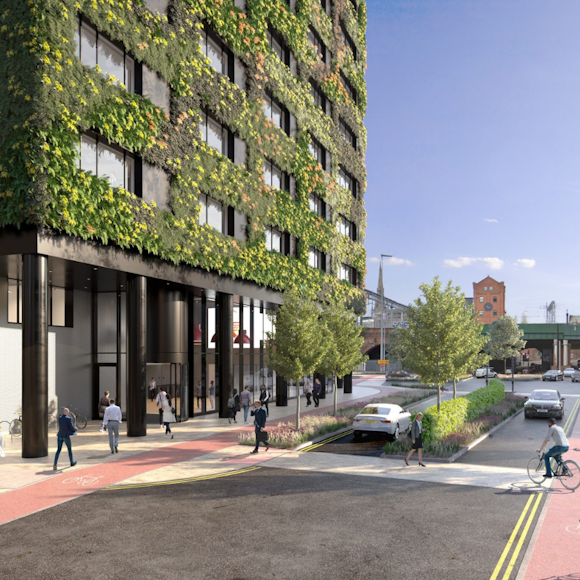Planting design is a specialised aspect of landscape architecture and horticulture that involves the creative arrangement and selection of plants. The primary goal of planting design is to create visually appealing, functional, and harmonious landscapes by strategically placing and combining various plants, such as trees, shrubs, perennials, grasses, and groundcovers.
Planting design truly comes to the forefront of its creative potential when applied to living walls. These vertical gardens provide an exceptional platform to showcase the harmonious interplay of various plant species, textures, and colours, to not only create a visually stunning masterpiece, but also to offer immense environmental assets.
In this blog post, we will delve into the creative craftsmanship behind planting design on living walls, uncovering the influence it wields on the visual appeal of built environments.
The science behind captivating planting design
Planting design is a captivating discipline that merges the art of design with the science of horticulture. It involves crafting outdoor spaces by thoughtfully selecting and arranging plants in a way that is aesthetically pleasing, functional, and ecologically sustainable. This process requires a deep understanding of both design principles and horticultural expertise to create landscapes that not only look appealing but also thrive in their intended environment.
The science behind planting design encompasses several key aspects:
- Site Analysis: Before any planting design takes place, thorough site analysis is essential. This involves assessing factors such as soil composition, drainage, sunlight exposure, climate conditions, and microclimates. A knowledgeable horticulturist can determine which plant species are best suited for the site's specific conditions, ensuring their long-term health and growth.
- Plant Selection: Horticultural expertise comes into play when selecting plants that are well-matched to the site's characteristics. Different plants have varying requirements for water, sunlight, soil type, and temperature. A skilled designer with horticultural knowledge can curate a diverse plant palette that not only harmonizes visually but also thrives harmoniously given the site's conditions.
- Ecological Considerations: Modern planting design often places a strong emphasis on ecological sustainability. Designers with horticultural expertise can create plant communities that mimic natural ecosystems, promoting biodiversity and reducing the need for excessive maintenance and resources like water and fertilizers.
- Design Principles: Effective planting design incorporates fundamental design principles such as balance, proportion, rhythm, contrast, and unity. These principles guide the arrangement of plants to create visually appealing compositions that resonate with the overall design concept. A designer with horticultural knowledge can ensure that the chosen plants not only fulfil their design roles but also complement each other as they grow and evolve.
- Seasonal Interest: Horticulturists understand the lifecycle of plants, enabling them to plan for year-round visual interest. By selecting plants with varying bloom times, foliage colours, and growth habits, designers can create landscapes that evolve with the seasons, providing dynamic and ever-changing displays.
- Maintenance and Growth: A well-executed planting design considers the long-term maintenance and growth of the chosen plants. Designers with horticultural expertise can anticipate how plants will develop over time, avoiding issues such as overcrowding and ensuring that the landscape remains visually pleasing as the plants mature.
- Adaptation to Change: Landscapes are not static; they change over time due to factors like plant growth, climate variations, and human interaction. Horticulturists understand these dynamics and can design landscapes that have flexibility to adapt to changes while maintaining their intended design integrity.
_luhji.jpeg?w=820&q=90&auto=format&fit=crop&crop=edges,focalpoint&fm=png)
The possibilities for planting design on living walls
Living walls, particularly when applied to commercial buildings, provide numerous possibilities for creative and functional planting design, extending beyond aesthetics.
These living art installations can help promote a brand’s identity, attract business and visitors to establishments, and leverage a heightened appreciation for nature through the beauty of planting design.
Let’s take a deeper dive into the possibilities for planting design on living wall installations:
Planting design for brand identity
Living walls can be used as a powerful branding tool for businesses and organisations. By incorporating company logos, colour schemes, or specific plant selections that resonate with a brand's values, a living wall becomes a living representation of the brand. This creates a memorable and impactful visual element that reinforces brand identity in a natural and visually appealing way.
In an age where visual content is key, the lush, vibrant, and unique nature of living walls captures attention, providing a fresh backdrop for photos and videos to be shared on social media platforms. Brands that incorporate brand elements and messages into these living canvases create content that's inherently shareable. Each photograph becomes not just a captured moment, but a piece of advertisement and exposure disseminated far and wide, extending the reach and visibility of a brand.
By encapsulating a brand’s logo or motifs in a living wall design, businesses can also forge a positive association between their identity and environmental values – improving brand perception and trust among clients, visitors, and customers.
For example, this interior living wall at the Czarnikow offices in London utilised a variety of plant species, textures, and colours, to portray the brands’ identity and values. This company specialises in around-the-world consulting, trading, and logistics management, and the planting design on their living wall installation certainly reflects this. Featuring a living ‘world map’ and the brand logo in contrasting colours, this wall is a true testament to the power of planting design for branding.
Planting design on living walls for visual impact and well-being
In today's interconnected world, the art of planting design on living walls holds the remarkable potential to generate captivating visual impact. With urban spaces progressively losing their natural allure, these innovative plant installations stand as potent tools to transform otherwise monotonous and drab landscapes into inviting and pleasurable environments.
These living walls, with their lush tapestries of vegetation cascading across otherwise blank surfaces, hold the power to turn uninspiring spaces into vibrant and welcoming environments. They reintroduce nature's palette of colours, textures, and scents into the heart of urban settings, revitalising the aesthetic fabric of cities.
Moreover, the strategic placement of living walls within urban landscapes offers more than just visual allure. It provides a subtle yet impactful way to reconnect individuals with nature, even amidst the bustling metropolis. The presence of these living installations introduces a sense of tranquillity and calm, offering a refuge from the fast-paced urban rhythm. The restorative effects of nature on human well-being are well-documented, and these living walls provide a harmonious solution to counterbalance the stresses of city living.
Planting design for encouraging a stronger appreciation of the environment
Planting design holds a profound potential to foster a deeper and more genuine appreciation for nature by showcasing its inherent beauty and its transformative impact on the ambiance and aesthetics of various spaces.
At its core, planting design serves as a visual ode to nature's intricate artistry. By thoughtfully selecting and arranging plant species, designers can mirror the harmonious compositions found in natural ecosystems. This replication of nature's design principles not only pleases the eye but also sparks curiosity and contemplation.
The deliberate incorporation of plant life in various contexts, from commercial spaces to residential areas, creates a tangible reminder of the environment's significance. As people encounter these natural elements in their everyday surroundings, they are reminded of the delicate balance between humanity and the natural world. This heightened awareness can inspire individuals to adopt more sustainable behaviours and advocate for the preservation of ecosystems.

Harness the Artistry of Planting Design on Living walls with Viritopia
Are you in the early stages of development? Are you looking to capitalise on environmental assets? Are you interested in learning more about living walls? Then look no further. Our team at Viritopia has you covered.
Viritopia has over 20 years of experience designing and maintaining biophilic infrastructure to create a detailed analysis of how a scheme will meet regulatory requirements. We help with a faster planning process and provide you with what’s needed to take your project to the next level. Head to our site to book a living wall consultancy or explore more about our green walls and their benefits.



